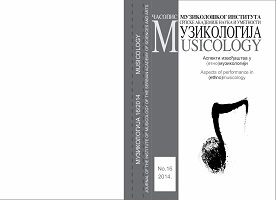Фолклорни мотиви у раним композицијама Николе Бороте Радована
Folklore Motives in the Early Compositions of Nikola Borota – Radovan
Author(s): Jelena JovanovićSubject(s): Customs / Folklore, Music, Cultural Anthropology / Ethnology, Sociology of Art, History of Art
Published by: Muzikološki institut SANU
Keywords: Yugoslav popular music; folk revival; Nikola Borota Radovan; Stone on stone; folklore motifs; musical idioms of the Balkans; Mediterranean and Central Europe; Glamock deaf circuit; world music;
Summary/Abstract: The creative work of Nikola Borota – Radovan (musician, composer, lyricist, arranger and record producer, based in New Zealand – formerly from Yugoslavia) held a specific place in development of world music (poly)genre in his native homeland in the early 1970s. This study focuses on his creative principles, applied to works published between the years 1970 and 1975 (while the role of these works in social, cultural and political context of the time and place will be elaborated in another study, see Јовановић 2014). The platform established to present this unique musical approach authenticaly was called kamen na kamen (a studio and stage outfit that has included number of collaborations over many years). Based on the musical models and aethetics of the folk revival and created under influence of The Beatles’, in adition to many other popular music production directions of the era, Borota’s works reveal significant musical, performance and production qualities, innovative expression and musical solutions, that need to be percieved from the contemporary (ethno)musicological point of view. Despite the fact that many prominent creative Yugoslav musicians of the time also worked within a similar framework I would argue that Mr. Borota’s creative outcome was signifficantly different from other Yugoslav popular music creative efforts. This is particularly noticeable in the author’s unique treatment of South-European and other folklore motives, which is the main topic of this study. Folk (ethnic) idioms exploited by Mr. Borota in his compositions originate from the rural traditions of western Dinaric regions. This is especially true for the rhythmic formations of deaf or silent dance; for the semi-urban and urban tradition of the Balkans and the Mediterranean; Middle European traditions; traditions from non-European peoples; elements of Italian Renaissance; and international (mostly Anglo-American) musical models. Compositions are analysed partly in accordance with the principles presented by Philip Tagg (1982), and following the principles of the “Finnish method” in ethnomusicology. According to my best knowledge, there was no previous comparable (ethno) musicological ellaboration of folk revival, Beatlesque influences and early forrays into world music within Yugoslav popular music culture. I therefore consider this study to be the first contribution to the research in this subject.
Journal: Muzikologija
- Issue Year: 1/2014
- Issue No: 16
- Page Range: 173-192
- Page Count: 20
- Language: Serbian

